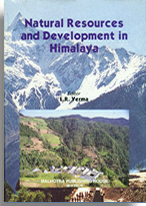Editor: L.R. Verma
 The
book entitled “Natural Resources and Development in Himalaya” is an outcome
of experience and knowledge gained by the editor (Prof L.R. Verma) as a professional
staff member in ICIMOD where studies on area based development of Himachal Pradesh
were made in comparison with other parts of Hindu-kush Himalaya . Later as a
Vice Chancellor of Dr. Y. S. Parmar University of Horticulture and Forestry
at Solan, Himachal Pradesh. Editor of this book got an opportunity to test and
translate the relevance of “Mountain Perspective” developed by ICIMOD in to
meaningful action programmes and these experiences are also reviewed in this
book.
The
book entitled “Natural Resources and Development in Himalaya” is an outcome
of experience and knowledge gained by the editor (Prof L.R. Verma) as a professional
staff member in ICIMOD where studies on area based development of Himachal Pradesh
were made in comparison with other parts of Hindu-kush Himalaya . Later as a
Vice Chancellor of Dr. Y. S. Parmar University of Horticulture and Forestry
at Solan, Himachal Pradesh. Editor of this book got an opportunity to test and
translate the relevance of “Mountain Perspective” developed by ICIMOD in to
meaningful action programmes and these experiences are also reviewed in this
book.
Section I includes a foreword by Director General ICIMOD explains
the divergent perspectives and issues related to development of mountain societies,
sustainable use and management of natural resources. This section discusses
strategies which make Himachal Pradseh a development model in Hindu-Kush Himalayan
region upland areas.
Section II deals with the integrated farming systems approach
including ITK. Significance of agriculture sector as the predominant one in
providing food, income and employment to the majority of mountain farmers throughout
Hindu-kush Himalayan region are discussed.
Section III identifies horticulture (fruits especially apple
production, off season vegetables and floriculture) as a lead farming sector
in Indian Himalaya ensuring economic prosperity to farmers.
Section IV deals with forest management, timber and non-timber
forest products and agroforestry systems. Multidisciplinary integrated approaches
to promote joint/participatory forest management leading to increased productivity,
equitable and sustainable use of forest resources are highlighted.
Section V provides historical perspective and present status
of plant biodiversity (domesticated and wild plant genetic resources, medicinal
and aromatic plants, seabuckthorn, honey plants, wild and cultivated mushrooms,
biofertilizers) which have helped mountain community to maintain richness of
ecosystem species and genetic diversity.
Section VI on animal genetic resources (livestock, Wildlife,
fisheries, apiculture and sericulture) present the complex interrelationship
between environment, animals, humans and levels of economic development.
Last section of this book covers physical resources viz.; soil, water, tourism,
renewable energy resources and hydropower potentials in mountain areas with
special reference to Himachal Pradesh. Extractive use of these resource have
put lot of pressure on mountain ecology adding to the problem of fragility despite
great potentials of these sectors in mountain economy.
ISBN : 81-85048-41-X
640+xviiipp; Hardcover
 The
book entitled “Natural Resources and Development in Himalaya” is an outcome
of experience and knowledge gained by the editor (Prof L.R. Verma) as a professional
staff member in ICIMOD where studies on area based development of Himachal Pradesh
were made in comparison with other parts of Hindu-kush Himalaya . Later as a
Vice Chancellor of Dr. Y. S. Parmar University of Horticulture and Forestry
at Solan, Himachal Pradesh. Editor of this book got an opportunity to test and
translate the relevance of “Mountain Perspective” developed by ICIMOD in to
meaningful action programmes and these experiences are also reviewed in this
book.
The
book entitled “Natural Resources and Development in Himalaya” is an outcome
of experience and knowledge gained by the editor (Prof L.R. Verma) as a professional
staff member in ICIMOD where studies on area based development of Himachal Pradesh
were made in comparison with other parts of Hindu-kush Himalaya . Later as a
Vice Chancellor of Dr. Y. S. Parmar University of Horticulture and Forestry
at Solan, Himachal Pradesh. Editor of this book got an opportunity to test and
translate the relevance of “Mountain Perspective” developed by ICIMOD in to
meaningful action programmes and these experiences are also reviewed in this
book.